
Salicornia is a genus of succulent, halophyte flowering plants in the family Amaranthaceae that grow in salt marshes, on beaches, and among mangroves. Salicornia species are native to North America, Europe, South Africa, and South Asia. Common names for the genus include glasswort, pickleweed, picklegrass, and marsh samphire; these common names are also used for some species not in Salicornia. To French speakers in Atlantic Canada, they are known, colloquially, as "titines de souris". The main European species is often eaten, called marsh samphire in Britain, and the main North American species is occasionally sold in grocery stores or appears on restaurant menus, usually as 'sea beans' or samphire greens or sea asparagus.

Sarcocornia is a genus of flowering plants in the amaranth family, Amaranthaceae. They are known commonly as samphires, glassworts, or saltworts. The genus has a cosmopolitan distribution, and is most diverse in the Cape Floristic Region of South Africa.

The Salicornioideae are a subfamily of the flowering plant family Amaranthaceae. Important characters are succulent, often articulated stems, strongly reduced leaves, and flowers aggregated in thick, dense spike-shaped thyrses. These halophytic plants are distributed worldwide.

Halimione portulacoides or sea purslane (2n=36) is a small greyish-green shrub widely distributed in temperate Eurasia and parts of Africa.

Kali turgidum, commonly known as prickly saltwort or prickly glasswort, is an annual plant that grows in salty sandy coastal soils.
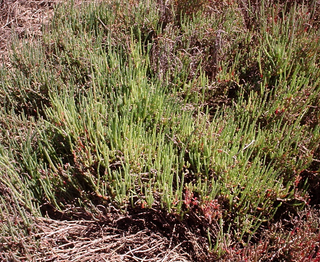
Tecticornia is a genus of succulent, salt tolerant plants largely endemic to Australia. Taxa in the genus are commonly referred to as samphires. In 2007, the genus Halosarcia, along with three other Australian genera was incorporated into the genus.
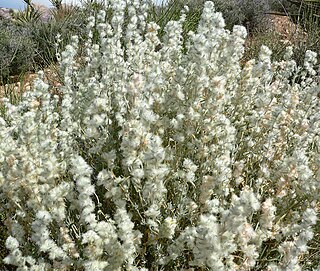
Krascheninnikovia is a genus of flowering plants in the subfamily Chenopodioideae of the family Amaranthaceae known as winterfat, so-called because it is a nutritious livestock forage. They are known from Eurasia and western North America. These are hairy perennials or small shrubs which may be monoecious or dioecious. They bear spike inflorescences of woolly flowers.
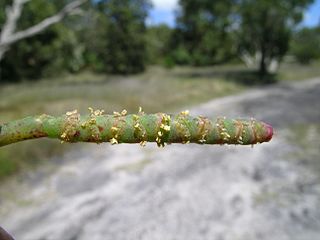
Sarcocornia quinqueflora, commonly known as beaded samphire, bead weed, beaded glasswort or glasswort, is a species of succulent halophytic coastal shrub. It occurs in wetter coastal areas of Australia and New Zealand.
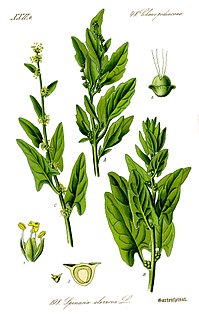
Spinacia is a flowering plant genus in the subfamily Chenopodioideae of the family Amaranthaceae. The most common member is spinach.
Arthrocnemum subterminale is a species of flowering plant in the Amaranth family known by the common name Parish's glasswort. This coastal and inland California native plant is a shrub that is found southerly into the northern states of Mexico, also in both coastal and inland areas, including salt marshes, alkali flats, and other habitats with saline soils.
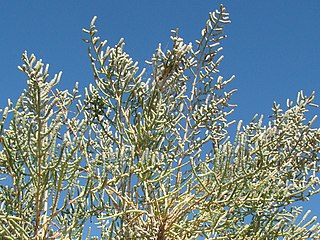
Halostachys is a genus of flowering plants in the plant family Amaranthaceae, containing a single species, Halostachys belangeriana. The plants are small to medium halophytic shrubs with apparently jointed fleshy stems and scale-like leaves. They are native to Asia and southeastern Europe.

Kalidium is a genus of flowering plants in the plant family Amaranthaceae. The species are shrubby halophytes distributed in Southeast Europe, Southwest Asia and Central Asia to China.

Chenopodiastrum is a genus of herbaceous flowering plants in the family Amaranthaceae. The genus was formally described in 2012. The 5 species occur in Eurasia, North Africa, and North America.

Oxybasis is a flowering plant genus from the subfamily Chenopodioideae of the family Amaranthaceae. It was first described in 1841, and newly used since 2012 for five species that were traditionally grouped into genus Chenopodium. They occur in Europe, Asia, North Africa and America.

Halimione is a plant genus from the subfamily Chenopodioideae of the family Amaranthaceae. It is a sister genus of Atriplex and has sometimes been included in this genus.
Proatriplex is a monotypic plant genus in the subfamily Chenopodioideae of the family Amaranthaceae, with the only species Proatriplex pleiantha. It is known by the common names Four-corners orach and Mancos shadscale. It occurs in the Navajo Basin of Arizona, Colorado, New Mexico, and Utah.

Heterostachys is a genus of flowering plants in the plant family Amaranthaceae. The two species are shrubby halophytes native to South America and Central America.

Arthrocnemum is a genus of shrubs in the family Amaranthaceae. Plants are halophytes with fleshy, apparently articulated plant stems and reduced leaves and flowers. There are two species, occurring from Southwest Asia and the Mediterranean region, to western tropical Africa and Macaronesia. An American species will have to be excluded.
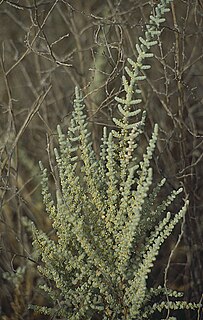
Halocnemum is a genus of halophytic shrubs in the family Amaranthaceae. The plants are fleshy and apparently articulated with characteristic globular or short-cylindrical lateral branches, and reduced leaves and flowers. There are two species, occurring from Southern Europe and North Africa to Asia.

Microcnemum is a genus in the plant family Amaranthaceae, containing a single species, Microcnemum coralloides. It is a dwarf annual halophyte with fleshy, apparently jointed stems and reduced leaves and flowers. The two subspecies show a disjunct distribution in Spain and Western Asia.


















